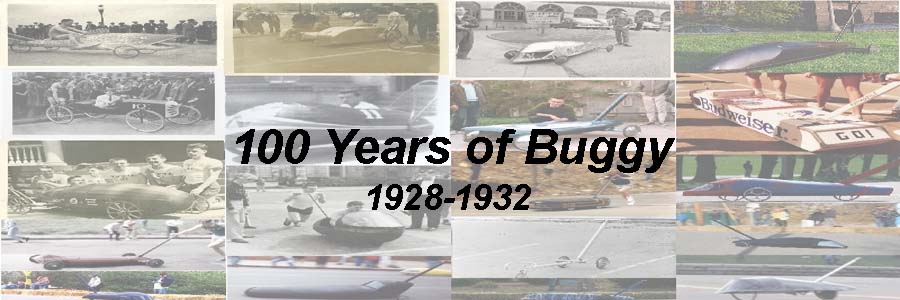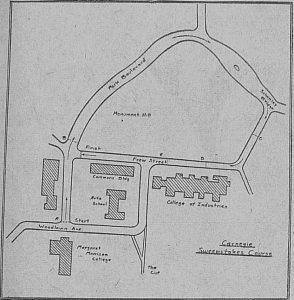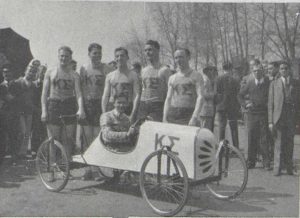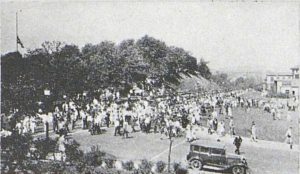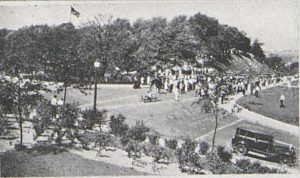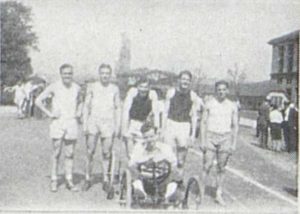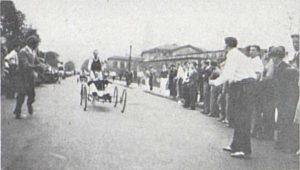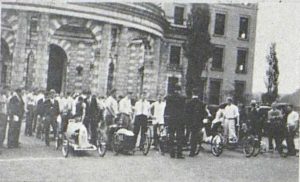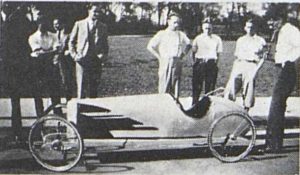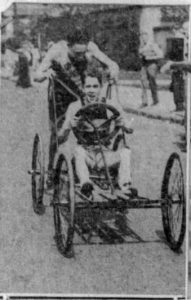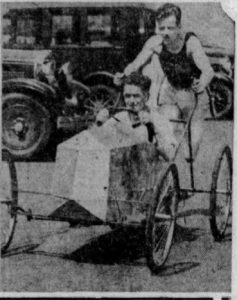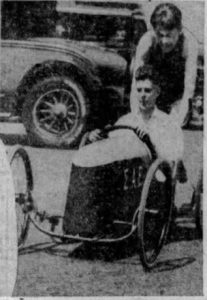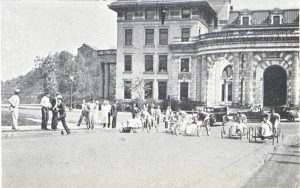Table of Contents: Intro & 1920; 1921-1923; 1924-1927; 1928-1932; 1933-1935; 1936-1939; 1940-1945; 1946-1949; 1950-1953; 1954-1956; 1957-1959; 1960-1963; 1964-1966; 1967-1969; 1970-1973; 1974-1976; 1977-1979; 1980-1983; 1984-1986; 1987-1989; 1990-1993; 1994-1996; 1997-1999; 2000-2003; 2004-2006; 2007-2009; 2010; 2011; 2012; 2013; 2014; 2015; 2016; 2017; 2018; 2019; Recap & 2020
This week, 100 Years of Buggy History gets into the late 1920s and early 1930s. Say hello to Frew Street, as the Buggy Course makes its final change, and goodbye to Campus Week, as the faculty worries about the impact of festivities on its students.
1928
Raceday: Prelims on Friday, May 4, 1928 @ 3:30pm; Finals on Saturday, May 5, 1928 @ 10:30am
Sweepstakes Committee: George Campbell (Chair), James Ashwell, John Wilkins, Morgan B. Maze, Thomas Lippert
Race Results: (1) KapSig; (2) SigNu; (3) Phi Kappa
Design Comp: SAE (Winner); Phi Sigma Kappa (Honorable Mention – Best Aesthetic Design)
Weather: Perfect; High of 81/86 (Low of 49/56)
1928 brought about the last major change to the course that has carried over for 92 years, and the races moved out of the Greek system for the first time. Meanwhile, Campus Week, the home of Buggy, was shortened to 2 days in a sign of things to come.
- Campus Week Shrinks. Campus Week, the precursor to Spring Carnival, was shortened from 3 days to 2 days (with fewer decorations and no “Mardi Gras” celebration) upon the decision of the Faculty Executive Committee. The result was that Friday’s prelims were pushed to the afternoon, rather than run in the morning, as more events had to be crammed into 1 fewer day.
- Frew Street Appears and the Final Course Change is Made. CMU officials put together a petition for the opening, grading, and paving of Frew Street late in 1926, and by March of 1928, Frew Street had been completed. Frew Street replaced Woodlawn Avenue beginning in the Chute, and extended the road until it intersected with Tech Street. As a result, the Buggy course was changed one final time, following Frew Street to the Frew/Tech intersection, rather than turning through campus and around CFA. That course is still intact today.
- Dorm Participation. For the first time, Buggy was opened to a non-Greek organization. In order to make Buggy an all-campus event, rather than just focused on the Greek system, the Men’s Dorms were permitted to enter Buggies; though it’s unclear if any actually did.
- Design Comp Trophy Change. In a change to the previous rules, the winner of the race is also permitted to win Design Comp (prior to 1928, if the winner of the race won Design Comp, the Design Comp trophy would go to the 2nd place Design Comp finisher).
- Buggies, Both Old and New. An unknown number of organizations entered Raceday 1928. But we do know something about most of those orgs’ buggies. Beta Sigma Rho, Beta Theta Pi, DTD, and PhiKap, all returned the same Buggies from 1927. ATO, Delta Mu (KDR), Delta Phi Delta, Kappa Sigma Rho, PiKA, SAE, SigNu, and Theta Xi, all brought back the same Buggies from 1927 but with some mechanical changes, new parts, or new designs. Alpha Sigma Phi, DU, Phi Kappa Psi, Phi Sigma Kappa, and SigEp, each built new Buggies for Raceday 1928.
- Prelim Heats. Heat #1 saw KapSig lead the entire way, finishing with a 3:08.6. ATO and Kappa Sigma Rho went into the freeroll 2nd and 3rd, respectively, but as they approached the finish line, SigEp caught Kappa Sigma Rho for 3rd (ATO finished 2nd). In Heat #2, SigNu went wire-to-wire, finishing in 3:13.6, while they were followed into the freeroll by SAE and Delta Phi Delta. By the finish line, Delta Phi Delta had passed SAE for 2nd, while SAE held on for 3rd. In Heat #3, PiKA was the one who led the entire way, finishing in 3:10.2, while Beta and DTD went into the freeroll in that order, but neck-and-neck. Eventually, DTD passed Beta for 2nd, and Beta had to settle for 3rd. In Heat #4, Theta Xi was first into the freeroll, but Phi Kappa, who was 3rd into the freeroll, managed to pass both Phi Sigma Kappa (who was 2nd early) and Theta Xi to win the heat in the top time of 3:05. Theta Xi held on to 2nd, and DU managed to finish 3rd. The top 2 from each of the 4 Heats (KapSig, ATO, SigNu, Delta Phi Delta, PiKA, DTD, Phi Kappa, Theta Xi) advanced to the Finals on Saturday.
- Finals. On the front hills, PiKA grabbed the early lead, going into the freeroll first. They were followed closely by Phi Kappa and Theta Xi. Unfortunately for PiKA, they couldn’t quite make it to the backhills, as they crashed in the chute. Ultimately, it was KapSig who crossed the finish line first, followed by SigNu and Phi Kappa. KapSig made a 4 second improvement off of their first day time and set the “course record” (of course, it was a new course) with a winning time of 3:04.4. KapSig’s winning team consisted of driver Robert Wright and pushers Allen, Lovewell, Stauffer, Flannigan, and Kennedy.
- Design Comp. SAE took home the design trophy thanks to their mechanical qualities.
- 1928 Photos. We have a few photos from Raceday 1928.
1929
Raceday: Prelims on Saturday, May 18, 1929 @ 10am; Finals on Saturday, May 25, 1929
Sweepstakes Committee: Unknown
Race Results: (1) PhiKap (3:05.6 – COURSE RECORD); KapSig and SigNu finished 2nd and 3rd (order is unknown)
Design Comp: Unknown
Weather: Rain for Prelims, High of 75/Low of 50; Sunny for Finals, High of 72/Low of 45
1929 saw the elimination of Campus Week, which left only Buggy to carry the torch of CMU traditions (and caused the races to run on back-to-back Saturdays). The lack of available Tartan archives limits our knowledge of the year a bit, but we do know a little.
- Campus Week Ends. In a vote in May 1928, the Faculty Executive Committee officially discontinued Campus Week, over the objections of the Student Council and student body. The faculty decided that Campus Week was too much of a distraction from schoolwork. A petition from the students in December 1928 would ultimately help usher in the 1930 Spring Carnival, but the result of no 1929 Campus Week meant that Buggy could only take place on Saturdays.
- Participation Shrinks. The other result of Campus Week being eliminated was that fewer organizations participated. In fact, there were only 10 teams competing in 1929, roughly half of the number of participants in 1928.
- Heats and Results. The Prelims were divided into 3 heats, and the winner of each Heat would then move onto the Finals the following week. Heat 1 consisted of 3 teams, and the heat was won by PhiKap (driver: Harry Kolb; Hill 5 Pusher: William Henderson). Heat 2 also consisted of 3 teams, and was won by KapSig (driver: Bob Wright). Heat 3 had 4 teams in total, and the winner was SigNu (driver: Bruce Finney). Ultimately, those 3 teams squared off the following week, and PhiKap raced to victory, in a course record 3:05.6. See photos below.
1930
Raceday: Prelims on Wednesday, May 7 @ 7:30pm; Finals on Saturday, May 10, 1930 @ 9:30am
Sweepstakes Committee: Dave Tomer (Chair), Albert Redding, James Leonard, Albert Scott, Harold Weitzel
Race Results: (1) Beta (2:57.5 – COURSE RECORD); (2) Phi Sigma Kappa
Design Comp: (1) Theta Xi
Weather: Sunny; High of 86/88, Low of 68/64
1930 witnessed the return of the 3-day festivities in the Spring semester, but this time under a new name…Spring Carnival. It also brought about a very unique Raceday structure.
- Introducing…Spring Carnival! After cancelling Campus Week in 1929, enough students banded together to convince the faculty to bring back the tradition on a trial basis, and the faculty approved the student council’s program in January 1930. The resulting event was dubbed Spring Carnival. Following its conclusion, the Tartan called it “the beginning of something new and something decidedly essential to the school and to the student body.” And 90 years later, here we are.
- Raceday on Wednesday? The official Spring Carnival program kicked off at 9pm on Thursday night with the Coronation Dance, and the Sweepstakes Finals were scheduled for Saturday from 9:30-11am. But due to the addition of an event called Circus Day (a.k.a. the Country Fair) on Friday morning, the Sweepstakes Prelims, which were originally expected to be on Friday at 10:30am, were moved to Wednesday evening, May 7, at 7:30pm.
- Small Fields Make For Unique Heats. The then-typical heat setup of the top 2 from 3 heats plus the next 2 fastest times advancing to the finals had to be scrapped when only 8 organizations entered a Buggy. Instead, the race was modified so that there were 4 total heats, with 2 Buggies in each heat. Of those, 6 of the 8 teams would qualify for the finals on Saturday (it was likely the winner of each heat, plus the two fastest 2nd place finishers).
- Orgs and Results. The 8 teams squaring off in Buggy were KapSig, PiKA, DTD, Beta, SigNu, PhiKap, Phi Sigma Kappa, and Theta Xi. Of those, the 6 who advanced to the Finals were SigNu, DTD, Beta, KapSig, PhiKap, and Phi Sigma Kappa (sorry to PiKA and Theta Xi). In the finals on Saturday morning, it was Beta who ended up on top, setting the course record in a 2:57.5, with Phi Sigma Kappa closely behind in 2nd.
- 1930 Photos. We have a handful of photos from 1930 courtesy of the 1931 Thistle.
1931
Raceday: Prelims on Friday, May 8 @ 10am; Finals on Saturday, May 9 @ 10:30am
Sweepstakes Committee: Dale Knouse (Chair – KapSig)
Race Results: (1) DTD (2:59), (2) Beta, (3) KapSig
Design Comp: (1) Theta Xi
Weather: Probably overcast (light rain in Pittsburgh on both days); High of 61/72, Low of 47/52
1931 saw a close race, with 3 preliminary heats leading into a very exciting finals.
- Pushing Rules are Relaxed. It’s unclear exactly when this happened, but some of the rules from the mid-1920s were relaxed by 1931. There was no longer a prohibition on track or cross-country athletes pushing a Buggy. This did cause a bit of an issue, however, because a track meet against Washington & Jefferson was scheduled for the Saturday of Finals. It’s unclear if any track athletes skipped the meet to push Buggy, though the Tartans’ domination of the Presidents by the score of 104-30 in the track meet suggests that no one stayed behind to push.
- Raceday Back to Friday. After a 2-year hiatus, Prelims moved back to its standard Friday slot, replacing the prior year’s Circus Day. It turns out that Circus Day did not give sufficient time in the day for Prelims, and there was far more interest in Buggy than in Circus Day.
- Pittsburgh Aviators Take to the Buggy Course. A report from the Pittsburgh Press on May 2, 1931 suggest that the Pittsburgh School of Aviation division of Main Aeronautics Company (I believe this is now known as the Pittsburgh Institute of Aeronautics) would be entering a Buggy on Raceday that was designed to look like Kaye Don’s Silver Bullet. It’s unclear how exactly they were entering, but my best guess is that this represents the entry of a new CMU fraternity, Lambda Chi Alpha (formerly Kappa Sigma Rho, which went dormant in 1935). Lambda Chi Alpha at Pitt seemed to have some connection to the aviation community.
- Heat Selections and Prelims. This year, all organizations were required to attend a Heat Selection meeting on Thursday at 11:30am, and failure to show up would result in a disqualification. Ultimately, 15 organizations entered the race. They were divided into 3 heats, in which the top 2 teams from each heat would advance to the Finals. The heats and results were:
- Heat 1: Alpha Sig, Theta Xi, DU, ATO and SAE – DU and SAE were the top 2 teams, and the Heat was won with a 3:15.5 time.
- Heat 2: Phi Kappa Psi, PhiKap, SigEp, SigNu, and Beta – SigEp and Beta were the top 2 teams, and the Heat was won with a 3:26 time.
- Heat 3: Lambda Chi Alpha, KapSig, Phi Sigma Kappa, DTD, and PiKA – KapSig and DTD were the top 2 teams, and the Heat was won with a 3:09.5 time.
- DTD Sweeps Pittsburgh. We don’t have a lot of details about the Finals. But we do know that it was very close. DTD managed to shave 10 seconds off of their Prelim time to win, with a 2:59 time, and Beta and KapSig finished very closely behind, with only a few yards distance between those 3. DTD’s winning buggy was driven by Ernest Lemon. But not only did DTD win CMU’s Buggy race, they also won Pitt’s buggy race! This was the first time that an organization swept both races. (And yes, Pitt had buggy too. More on that next week).
- Travelling Trophy. DTD’s win earned them a trophy. But early in the fall of 1932, they noticed that their precious trophy had gone missing! One week later, the trophy was returned to them by mail.
1932
Raceday: Prelims on Friday, May 20 @ 11am; Finals on Saturday, May 21 @ 11am
Sweepstakes Committee: Lorin C. Brown (Chair – SigNu)
Race Results: (1) Beta (2:54.8 – COURSE RECORD); (2) DTD; (3) ATO
Design Comp: (1) Theta Xi; (2) Beta
Weather: Sunny; High of 83/82, Low of 51/59
1932 saw a couple of rule additions, the introduction of lanes to the course, and the first of many devastating DQs.
- Designs Must Race. In 1932 a new rule was added that to be eligible for Design Competition, the Buggy must actually race. It’s unclear why this rule was added (possibly to get more buggies racing?); one can only imagine a rash of orgs that decided “let’s build this Buggy but not bother to actually race it!”. Another older rule returned as well, as track and cross-country runners were once again deemed ineligible to participate.
- Alternates Permitted. For the first time, orgs were allowed to submit the name of 2 alternates on their roster, in addition to the 5 pushers and 1 driver, in order to provide for a backup in the event of an injury or illness.
- Front Hills Add Lanes. Traffic flow must have been a problem on Tech and Schenley, because in 1932 the City of Pittsburgh decided to add traffic dummies and flashers to the top of the hill. This created an imbalance on the front hills, and therefore Sweepstakes decided to create lanes for the buggies. Any buggy leaving its lane prior to the neutral zone at the top of Hill 2 would be DQ’d, and spectators were warned to stay off the street on the front hills to avoid interfering with the outside buggies.
- Beta TRIes a New Design. The rule requiring buggies to have 4 wheels was eliminated at some point, so Beta decided to try something radical in 1932 – a 3-wheeler! Designed as a standard trike, it turned out to be a successful experiment, as Beta won the race in a new course record time of 2:54.8, shaving almost 3 seconds off of their prior course record. The design also earned them a 2nd place finish in the Design Competition.
- Prelim Heats. We don’t know exactly how many teams competed, but we do know it was at least 9. The race was run in 3 heats, with the top 2 from each heat advancing to the finals. KapSig led the field heading into the finals, but given how spread out times were in the early era, the buggies were all packed closely together. The heat results were:
- Heat 1: (1) Beta (3:05), (2) Phi Kappa Psi, (3) SigNu (Beta and Phi Psi advance)
- Heat 2: (1) KapSig (3:03), (2) DTD, (3) DU (KapSig and DTD advance)
- Heat 3: (1) Theta Xi (3:08), ATO, (3) Alpha Sig (Theta Xi and ATO advance)
- Phi Psi’s Bad Day. In the finals, all 6 orgs were bunched together until the final stretch. But on Hill 5, it was Phi Kappa Psi who pulled into the lead. They went on to cross the finish line first! Unfortunately, Hill 5 pusher George Kavel was one of many over the years who misjudged how fast the buggy would roll on Hill 5, and the buggy crossed the finish line without a pusher. As the May 24 Tartan wrote, “the Phi Psi car crossed the finish line first but did it so easily that it didn’t need a pusher at the finish.” That resulted in Phi Psi being DQ’d for a pushbar violation, handing the win over to Beta’s 3-wheeler.

